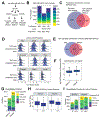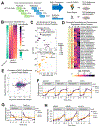Multiplexed Relative Quantitation with Isobaric Tagging Mass Spectrometry Reveals Class I Major Histocompatibility Complex Ligand Dynamics in Response to Doxorubicin
- PMID: 30779550
- PMCID: PMC7302430
- DOI: 10.1021/acs.analchem.8b05616
Multiplexed Relative Quantitation with Isobaric Tagging Mass Spectrometry Reveals Class I Major Histocompatibility Complex Ligand Dynamics in Response to Doxorubicin
Abstract
MHC-I peptides are intracellular-cleaved peptides, usually 8-11 amino acids in length, which are presented on the cell surface and facilitate CD8+ T cell responses. Despite the appreciation of CD8+ T-cell antitumor immune responses toward improvement in patient outcomes, the MHC-I peptide ligands that facilitate the response are poorly described. Along these same lines, although many therapies have been recognized for their ability to reinvigorate antitumor CD8+ T-cell responses, whether these therapies alter the MHC-I peptide repertoire has not been fully assessed due to the lack of quantitative strategies. We develop a multiplexing platform for screening therapy-induced MHC-I ligands by employing tandem mass tags (TMTs). We applied this approach to measuring responses to doxorubicin, which is known to promote antitumor CD8+ T-cell responses during its therapeutic administration in cancer patients. Using both in vitro and in vivo systems, we show successful relative quantitation of MHC-I ligands using TMT-based multiplexing and demonstrate that doxorubicin induces MHC-I peptide ligands that are largely derived from mitotic progression and cell-cycle proteins. This high-throughput MHC-I ligand discovery approach may enable further explorations to understand how small molecules and other therapies alter MHC-I ligand presentation that may be harnessed for CD8+ T-cell-based immunotherapies.
Conflict of interest statement
The authors declare no competing financial interest.
Figures





References
-
- Castle JC; Kreiter S; Diekmann J; Lower M; van de Roemer N; de Graaf J; Selmi A; Diken M; Boegel S; Paret C; et al. Cancer Res. 2012, 72 (5), 1081–1091. - PubMed
-
- Yadav M; Jhunjhunwala S; Phung QT; Lupardus P; Tanguay J; Bumbaca S; Franci C; Cheung TK; Fritsche J; Weinschenk T; et al. Nature 2014, 515 (7528), 572–576. - PubMed
-
- Lemmel C; Weik S; Eberle U; Dengjel J; Kratt T; Becker H-D; Rammensee H-G; Stevanović S Nat. Biotechnol 2004, 22 (4), 450–454. - PubMed
Publication types
MeSH terms
Substances
Grants and funding
LinkOut - more resources
Full Text Sources
Other Literature Sources
Medical
Molecular Biology Databases
Research Materials

